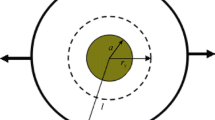Abstract
This chapter aims to model the mechanical behavior of particle-reinforced metal matrix composites with particle cracking. Specifically a micromechanics-based elastoplastic constitutive model is coupled with damage mechanics due to particle cracking to predict the overall mechanical behavior of particle-reinforced metal matrix composites. Unidirectionally aligned spheroidal elastic particles, some of which contain penny-shaped cracks, are randomly distributed in the elastoplastic metal matrix. These imperfect particles, attributed to progressive particle cracking, are modeled by using the double-inclusion concept. The ensemble-volume averaged homogenization procedure is employed to estimate the effective yield function of the damaged composites. The elastoplastic mechanical behavior of particulate composites under uniaxial loading condition is simulated and compared with available experimental results.
Similar content being viewed by others
References
G. Bao, Damage due to fracture of brittle reinforcements in a ductile matrix. Acta Metall. Mater. 40(10), 2547–2555 (1992)
M. Berveiller, A. Zaoui, An extension of the self-consistent scheme to plastically-flowing polycrystals. J. Mech. Phys. Solids 26, 325–344 (1979)
N. Bourgeois, Caracterisation et modelisation micromecanique du comportement et de lendommagement dun composite a matrice metallique, Al/SiCp. Doctoral Thesis, Ecole Centrale des Arts et Manufactures: Chatenay-Malabry, France, 1994
J.R. Brockenbrough, F.W. Zok, On the role of particle cracking in flow and fracture of metal-matrix composites. Acta Metall. Mater. 43(1), 11–20 (1995)
T.W. Clyne, P.J. Withers, An Introduction to Metal Matrix Composites (Cambridge University Press, Cambridge, 1993)
K. Derrien, J. Fitoussi, G. Guo, D. Baptiste, Prediction of the effective damage properties and failure properties of nonlinear anisotropic discontinuous reinforced composites. Comput. Methods Appl. Mech. Eng. 185, 93–107 (2000)
J.D. Eshelby, The determination of the elastic field of an ellipsoidal inclusion and related problem. Proc. R. Soc. Lond. A. 241, 376–396 (1957)
M. Finot, Y.L. Shen, A. Needleman, S. Suresh, Micromechanical modeling of reinforcement fracture in particle-reinforced metal-matrix composites. Metall. Mater. Trans. A 25(11), 2403–2420 (1994)
S. Ghosh, S. Moorthy, Particle fracture simulation in non-uniform microstructures of metal-matrix composites. Acta Mater. 46(3), 965–982 (1998)
C. Gonzalez, J. Llorca, A self-consistent approach to the elasto-plastic behaviour of two-phase materials including damage. J. Mech. Phys. Solids 48, 675–692 (2000)
A.L. Gurson, Continuum theory of ductile rupture by void nucleation and growth, part I – yield criterion and flow rules for porous ductile media. ASME J. Eng. Mater. Technol. 99(1), 2–15 (1977)
R. Hill, Continuum micro-mechanics of elastoplastic polycrystals. J. Mech. Phys. Solids 13, 89–101 (1965)
M. Hori, S. Nemat-Nasser, Double-inclusion model and overall moduli of multi-phase composites. Mech. Mater. 14, 189–206 (1993)
J.W. Ju, T.M. Chen, Micromechanics and effective moduli of elastic composites containing randomly dispersed ellipsoidal inhomogeneities. Acta Mech. 103, 103–121 (1994)
J.W. Ju, L.Z. Sun, A novel formulation for exterior-point Eshelby’s tensor of an ellipsoidal inclusion. ASME J. Appl. Mech. 66, 570–574 (1999)
J.W. Ju, L.Z. Sun, Effective elastoplastic behavior of metal matrix composites containing randomly located aligned spheroidal inhomogeneities, Part I: micromechanics-based formulation. Int. J. Solids Struct. 38, 183–201 (2001)
J.W. Ju, K.H. Tseng, Effective elastoplastic algorithms for ductile matrix composites. ASCE J. Eng. Mech. 123(3), 260–266 (1997)
K. Lee, S. Moorthy, S. Ghosh, Multiple scale computational model for damage in composite materials. Comput. Methods Appl. Mech. Eng. 172, 175–201 (1999)
M. Li, S. Ghosh, O. Richmond, H. Weiland, T.N. Rouns, Three dimensional characterization and modeling of particle reinforced metal matrix composites part II: damage characterization. Mater. Sci. Eng. A 266, 221–240 (1999)
H.T. Liu, L.Z. Sun, J.W. Ju, Elastoplastic modeling of progressive interfacial debonding for particle-reinforced metal matrix composites. Acta Mech. 181, 1–17 (2006)
J. Llorca, J.L. Martinez, M. Elices, Reinforcement fracture and tensile ductility in sphere-reinforced metal-matrix composites. Fatigue Fract. Eng. Mater. Struct. 20(5), 689–702 (1997)
T. Mochida, M. Taya, M. Obata, Effect of damaged particles on the stiffness of a particle/metal matrix composite. JSME Int. J. Ser. I. Solid Mech. Strength Mater. 34(2), 187–193 (1991)
T. Mori, K. Tanaka, Average stress in matrix and average elastic energy of materials with misfitting inclusions. Acta Metall. 21, 571–574 (1973)
T. Mura, Micromechanics of Defects in Solids, 2nd edn. (Kluwer, Dordrecht, 1987)
S. Nemat-Nasser, M. Hori, Micromechanics: Overall Properties of Heterogeneous Materials, 2nd edn. (North-Holland, Amsterdam, 1999)
H.M. Shodja, A.S. Sarvestani, Elastic fields in double inhomogeneity by the equivalent inclusion method. ASME J. Appl. Mech. 68(1), 3–10 (2001)
D. Steglich, T. Siegmund, W. Brocks, Micromechanical modeling of damage due to particle cracking in reinforced metals. Comput. Mater. Sci. 16(1–4), 404–413 (1999)
L.Z. Sun, J.W. Ju, Effective elastoplastic behavior of metal matrix composites containing randomly located aligned spheroidal inhomogeneities, Part II: applications. Int. J. Solids Struct. 38, 203–225 (2001)
L.Z. Sun, H.T. Liu, J.W. Ju, Effect of particle cracking on elastoplastic behavior of metal matrix composites. Int. J. Numer. Method Eng. 56, 2183–2198 (2003)
S. Suresh, A. Mortensen, A. Needleman, Fundamentals of Metal-Matrix Composites (Butterworth-Heinemann Publisher, Boston, 1993)
G.P. Tandon, G.J. Weng, A theory of particle-reinforced plasticity. ASME J. Appl. Mech. 55, 126–135 (1988)
V. Tvergaard, A. Needleman, Analysis of the cup-cone fracture in a round tensile bar. Acta Metall. 32(1), 157–169 (1984)
W. Weibull, A statistical distribution function of wide applicability. ASME J. Appl. Mech. 18, 293–297 (1951)
D.S. Wilkinson, E. Maire, J.D. Embury, The role of heterogeneity on the flow of two-phase materials. Mater. Sci. Eng. A 233(1–2), 145–154 (1997)
D.S. Wilkinson, W. Pompe, M. Oeschner, Modeling the mechanical behaviour of heterogeneous multi-phase materials. Prog. Mater. Sci. 46, 379–405 (2001)
Author information
Authors and Affiliations
Corresponding author
Editor information
Editors and Affiliations
Rights and permissions
Copyright information
© 2014 Springer Science+Business Media New York
About this entry
Cite this entry
Sun, L.Z., Liu, H.T., Ju, J.W. (2014). Particle-Cracking Modeling of Metal Matrix Composites. In: Voyiadjis, G. (eds) Handbook of Damage Mechanics. Springer, New York, NY. https://doi.org/10.1007/978-1-4614-8968-9_9-1
Download citation
DOI: https://doi.org/10.1007/978-1-4614-8968-9_9-1
Received:
Accepted:
Published:
Publisher Name: Springer, New York, NY
Online ISBN: 978-1-4614-8968-9
eBook Packages: Springer Reference EngineeringReference Module Computer Science and Engineering




